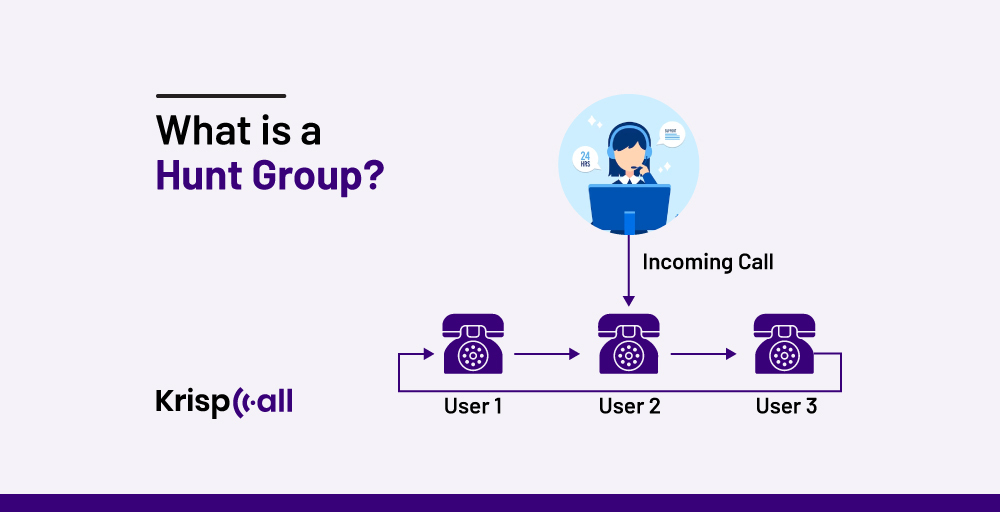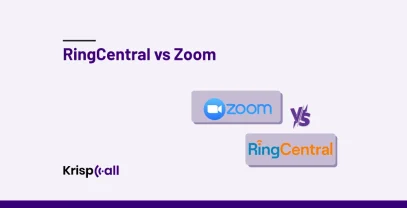If you run a business that receives many calls, you know how important it is to connect your customers with the right person or department as quickly as possible. 📞
But what happens if you need more time to answer the phone if all of your lines are busy? How do you keep your clients from reducing or getting angry with them?
That’s where a hunt group comes in handy. 😊
A hunt group is an automated feature that allows businesses to distribute calls to groups of people within their organization.
In this blog, you will learn everything you need to know about hunt groups.
🔑 Key points
- A hunt group efficiently routes incoming calls to the appropriate person or department in a business.
- It helps manage high call volumes by distributing calls among multiple lines or extensions.
- Circular hunt groups distribute calls in a circular pattern among lines or extensions within the group.
- Real-world applications include customer support, sales teams, service centers, and technical support departments.
What is a Hunt Group?
A hunt group is a way of routing incoming calls to a group of users or devices, based on a set of rules. It helps you connect your callers with the right person or department quickly and efficiently.

It is designed to distribute incoming calls among several lines or extensions in an effective manner, decreasing the possibility of missed calls and guaranteeing that calls are immediately addressed.
A hunt group can help you improve your customer service, increase your efficiency, and optimize your phone system. 💯
Example: Suppose a customer calls a company’s main phone number. The Hunt Group system automatically forwards the call to the available sales representative. If the first representative is busy, it tries the next one in line until someone answers. This ensures efficient call handling and a positive customer experience.
What are the benefits of hunt groups?
Hunt groups can help your business achieve better results and higher standards by organizing and managing your calls more effectively.
Here are some of the benefits of using hunt groups for your business:
- Efficient call distribution: Incoming calls are automatically divided among a collection of lines or extensions when a hunt group is set up. Because calls are quickly directed to team members who are accessible, there is a decreased chance that they will be missed or go unanswered.
- Reduced wait times for customers: Hunt groups assist in cutting down on client wait times by dividing up incoming calls over several lines or extensions. Calls are split across many lines concurrently rather than being routed to a single line or extension, which can cause busy signals or lengthy wait times during peak hours.
- Improved team collaboration: Hunt groups divide incoming calls across several team members, which facilitates teamwork. Team members can take calls from the first person in the group to become available, instead of answering calls on their lines. This increases call efficiency and promotes collaboration, particularly during busy hours.
What are the different types of hunt groups?
The different types of hunt groups are:
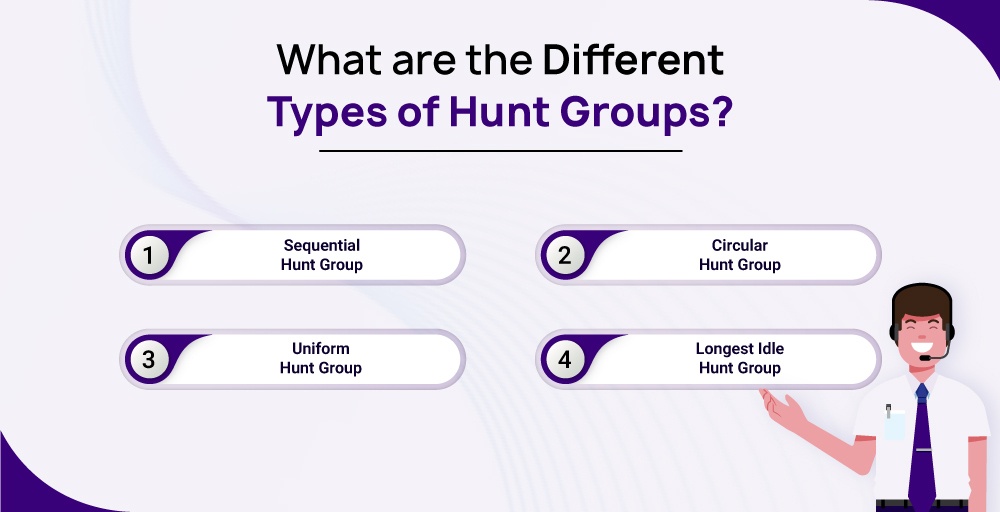
1. Sequential Hunt Group
Incoming calls are distributed among the lines or extensions in a sequential search group in a predetermined order or sequence. Usually, the call is routed to a designated line or extension first.
The call is automatically sent to the next line in line sequence by the system if that line is busy or unavailable. Until an open line is discovered or the sequence’s conclusion is reached, this procedure keeps going. Sequential search groups are useful for making sure that team members handle calls equally and that everyone gets a turn handling calls.
2. Circular Hunt Group
Within their group, circular hunt groups divide incoming calls among their lines or extensions in a circular pattern. The call is first connected to a certain extension or line.
The system cyclically routes calls, moving on to the next line or extension in the sequence when the current call is over or if the line is busy. Call handling responsibilities may be balanced, and calls are allocated equally among team members in this kind of hunt group.
3. Uniform Hunt Group
Among the lines or extensions in a uniform hunt group, the system calls each one equally. This kind of hunt group seeks to maintain parity in call distribution by guaranteeing that every line or extension receives an equal amount of calls, preventing overflows on certain lines.
When it comes to call handling, uniform hunt groups are very helpful for preserving balance.
4. Longest Idle Hunt Group
Calls to the line or extension that has been idle for the longest are given priority by groups with the longest idle hunts. Callers wait less time, and efficiency is maximized as a result of incoming calls being routed to the resource that is most accessible.
This kind of hunt group makes sure that calls are handled efficiently and quickly by routing them to the longest idle resource.
How Does a Hunt Group Work?
An organization’s hunt group can be used as an effective way to handle incoming calls. Here is how it works:
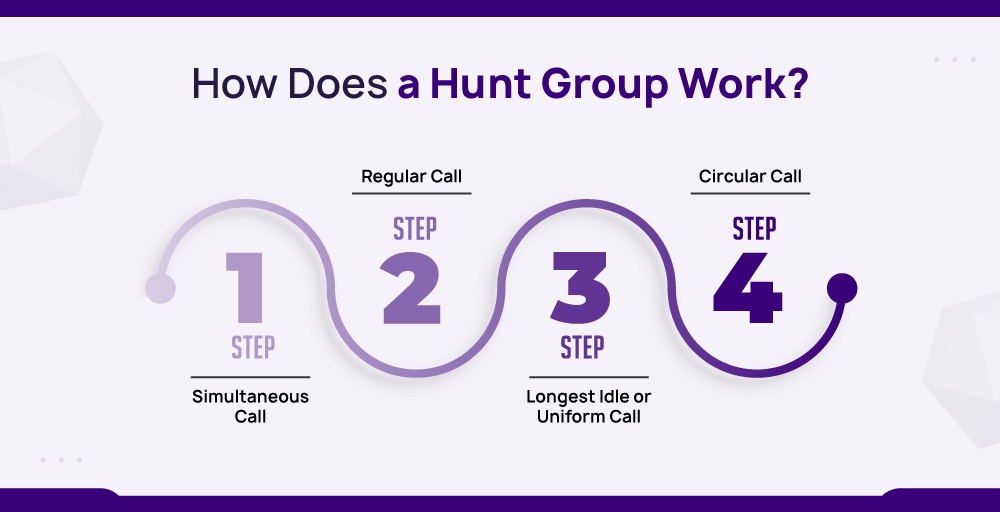
- Simultaneous Call: All of the group phones ring at the same time when a call is received. The call can be taken by any operator or group member who is available.
- Regular Call: The hunt group calls each number on its list one after the other. Calls to busy or unanswered primary lines are routed to the next available extension.
- Longest Idle or Uniform Call: Calls are forwarded to the phone that hasn’t been utilized in the past using this technique. The call transfers to the next open line if that one is already in use.
- Circular Call: Calls ring each phone in turn in a circular manner. The cycle repeats until someone answers if the call goes unanswered.
Phone calls go to voicemail if no one picks up. Hunt groups allow members to sign in and out to avoid needless ringing. You will get calls for the team when you join a hunt group, and your screen will show you if the call is coming from your direct work line or the group number.
Real-world Applications of Hunt Groups: Where They Are Used?
Companies in a range of sectors use hunt groups in distinct divisions to increase productivity and simplify communication.
Here are some examples of how hunt groups are used in various business contexts in the real world:
Customer support departments
- When customers call for help, the system sends their call to an available support agent.
- Reduces waiting time and makes customers happier
a. Technical Support
To assign incoming client calls to available support personnel, a technical support department might employ search groups. Calls can be routed according to an agent’s availability, area of expertise, or language skills.
b. Customer Care Hotlines
When consumers call customer care hotlines to ask questions or get problems resolved, they are frequently placed in hunt groups. Customer care agents might take turns fielding calls to guarantee timely assistance.
Sales teams
- Distribute sales calls to the right salespeople.
- Ensures timely follow-ups with potential customers.
a. Inbound Sales Calls
Sales teams use hunt groups to answer incoming sales calls from prospective clients. Sales reps may be assigned calls according to their availability, product knowledge, or area.
b. Lead Distribution
Sales reps can also get inbound leads from marketing campaigns or internet inquiries by using hunt groups. This optimizes conversion chances and guarantees that leads are swiftly followed up on.
Service centers
- Routes service requests to technicians or specialists.
- It helps fix things faster.
a. Field Service deploy
Hunt groups can be used to assign incoming service requests to available technicians in service centers that deploy field technicians or service professionals. Calls can be routed according to the availability, location, or level of skill of the professional.
b. Appointment Scheduling
To handle consumer appointment requests, service centers can use hunt groups. Agents in charge of booking appointments can take calls for various services, including maintenance, installations, and repairs.
Hunt Group Vs Call Queue: What are the differences?
Hunt group vs. call queue: simply explain below:
| Aspect | Hunt Group | Call Queue |
| Purpose | Distribute incoming calls within an organization. | Manage call flow and distribute calls efficiently. |
| Routing Behavior | Calls are routed to a set of users according to a specified way. | If all agents are unavailable, calls are routed to other users after being held in a queue. |
| Suitability | Does not include queuing functionality. | Include queuing functionality. |
| Sutability | Excellent in situations where standing in line is not necessary. | Ideal for interior usage in situations where lines are required. |
| Reporting | Basic reporting provided | Offers enhanced customization, complexity, and management. |
| Cost | Generally more cost-effective | Perhaps more costly because of the extra features. |
What are the Best Practices for Hunt Group Implementation?
Step1: Create a Group
- To begin, establish a group for your hunt.
- Consider it the formation of a team inside your company.
Add Members to the Hunt Group
- Identify the individuals who will take calls.
- Give the group access to their phone numbers or extensions.
- These participants will be involved in the call distribution procedure.
Step 2: Assign Operators and Phones
- Name the team members that will take on the role of operators.
- Select the phones or gadgets they’ll use to take calls.
- You can designate certain mobile devices or desk phones, for instance.
Step 3: Set Up Business Hours and Call Handling
- Describe the hours that the Hunt Group is open for business.
- For example, on weekdays, it may be from 9:00 AM to 6:00 PM.
- Choose a response strategy for calls received beyond these hours (such as voicemail or forwarding).
Set Up Rules for Call Forwarding:
- Decide what should happen in the event of a call.
- When the first person answers the phone, who should you contact next?
- Establish call forwarding rules according to availability.
Step 4: Select the Type of Hunting Calls and Execute
Select one of two modes:
1. Hunt Group Linear:
- Calls are routed to the next person in line who is available.
- It moves on to the next individual if the first one is occupied.
2. Round Robin (Circular Hunt Group):
- Team members take calls in a circular pattern.
- Ensures that calls are distributed fairly.
Hunt Group Vs Ring Group: What are the differences?
The differences between the hunt group and the ring group are :
| Aspect | Hunt Group | Ring Group |
| Purpose | Organize incoming calls inside a company according to preset standards. | Ring every group member at the same time. |
| Suitability | Calls are sequentially routed to group members according to defined guidelines. | All lines ring simultaneously, and the first person to answer handles the call. |
| Sutability | Perfect for situations when department-specific routing is needed. | Useful for consistently managing large call volumes. |
| Reporting | Basic reporting provided | Limited reporting features |
| Advantages | Efficient call distribution | Faster call pickup for incoming calls. |
Distribute incoming calls to the Right Department/Team with the KrispCall Hunt Group Feature!
KrispCall is a VoIP phone System that allows all incoming calls to be distributed among a group of employees or extensions within a department. When a call comes in, KrispCall uses a hunt group phone system to set a predetermined set of rules to decide which agent or extension should receive the call.
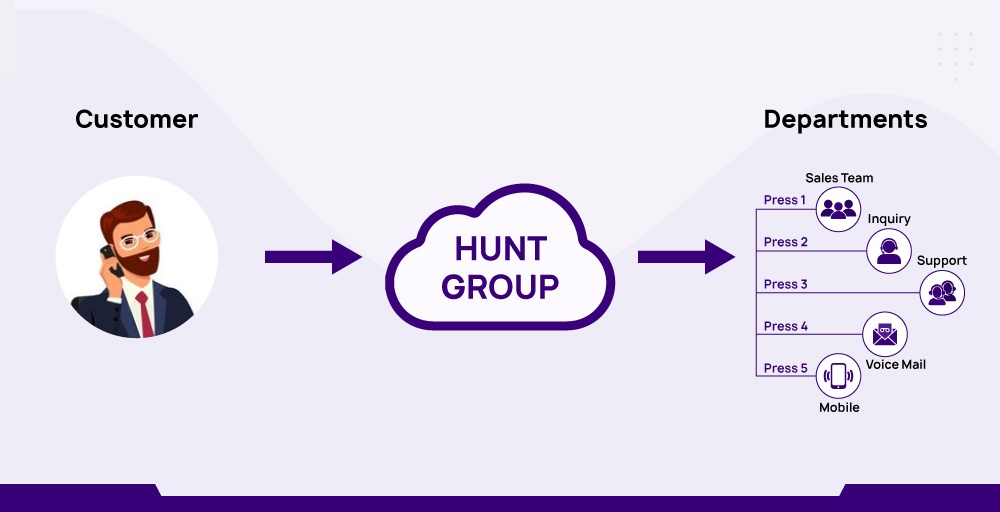
With the help of KrispCall sequential hunt, the call is routed to the first available agent in the department. If that team is busy or unavailable then the call is routed to the next available employee in sequence until someone answers the call.
With this KrispCall feature your client doesn’t have to wait a long time. This will improve the efficiency and productivity of your business. Get this hunt group feature at a reasonable price with KrispCall to connect your customers with the right person or department as quickly as possible.
Conclusion
A hunt group is an important communication tool that companies utilize to effectively handle incoming calls and provide timely customer responses. It enables companies to divide incoming calls among a set of lines or extensions under preset guidelines or standards.
Hunt groups have several advantages, such as better teamwork, shorter client wait times, and effective call allocation. Utilizing features like KrispCall’s hunt group functionality can further enhance efficiency and productivity, ultimately leading to improved customer satisfaction and business success.
A hunt groups play a crucial role in streamlining communication, improving customer service, and optimizing call handling within organizations across various industries.
Try KrispCall to avoid a long wait to receive client calls.
FAQ
What is a hunt group in telecommunication?
A hunt group is a telecommunication feature that distributes incoming calls among a group of phone lines or extensions based on predefined rules or criteria.
Can I prioritize certain team members in a hunt group?
Yes, you can prioritize certain team members in a hunt group by setting up rules or criteria for call distribution. For example, you can route calls to specific team members based on their availability, expertise, or role within the organization.
Is it possible to reassign agents to multiple hunt groups?
Yes, It is feasible to move agents around among different hunt groups. Agents may manage calls from several teams or divisions inside the company by participating in many hunt groups at once.
What are circular hunt groups?
Circular hunt groups are a type of hunt group where incoming calls are distributed among the lines or extensions in a circular pattern. Calls are routed to the next line or extension in the sequence, ensuring balanced call handling among team members.

